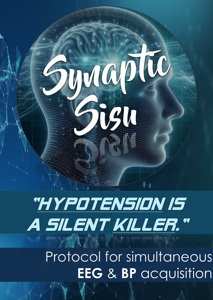Synaptic Sisu 2025
Project objectives
Better understanding of the correlation between the changes in electroencephalography (EEG) and blood pressure (BP) can serve as a baseline for studying and introducing new approaches to medical conditions affecting nervous and cardiovascular systems. To enable research for this association, we implemented a study protocol for simultaneous data acquisition of EEG and BP, with four interventions intended to trigger brain activity: stroop test, auditory simulation, mental math and passive leg raise.
Methodology and implementation
During the interventions, real-time EEG and BP values of the test participants are simultaneously recorded in accordance with the protocol guidelines. The tests were taken with two measurement systems: BIOPAC MP-160 with two EEG100C amplifiers (four electrodes in total) for EEG instrumentation and CNSystems CNAP Monitor 500 for BP instrumentation. Utilizing Python, we analyzed the correlation of the relevant data points in our report for each instance. In addition, we created a separate script for the detection of positives (peaks) and negatives (falls) and crossings of zero-point in the data graphs for future reference.
Results
We managed to create a study protocol for simultaneous measurement, which was validated with non-clinical testing (five iterations in total). We concluded that the protocol is functional for these purposes. Data analysis results in particular highlight the importance for further research. While the overall correlations are generally low in our findings across the spectrum, we discovered the highest correlation with BP among alpha (α) waves of EEG, which is a promising outcome.
Intervention impact on the EEG intensity growth, when compared to the 5-minute resting state, can be noticed across the spectrum. The most significant on-average increase was seen with Mental Math intervention, with 32.7% concerning both channels. The highest individual result was identified in the Stroop Test with first channel EEG, with a 43.9% increase in intensity. A broader, notable trend can be discovered with the interventions used. On average, there is an increase of 21% in EEG intensity across 5 test iterations with 36 measurements/set of data (20 AF7-AF8 + 16 TP9-TP10).

